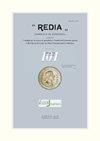突尼斯东北部有机柑橘园鳞片昆虫种类的进一步数据:生物多样性、丰度和天敌
IF 0.6
4区 生物学
Q3 ZOOLOGY
引用次数: 0
摘要
Elimem M.、Jendoubi H.、Lahfe C.、Limem Sellemi E.、Ben Belgacem L.、Kalboussi M.、Rouz S.——关于突尼斯东北部有机柑橘园中介壳虫物种的进一步数据:生物多样性、丰度和天敌。总是需要对害虫进行动物学研究,以更新一个国家的物种清单,并启发新的潜在物种的出现。在突尼斯东北部(扎格胡安省)的一个有机果园中,对柑橘的鳞片昆虫区系和相关天敌进行了调查。记录了每种规模昆虫的发生率、发生率、优势度和生物多样性参数。在三年(2017年、2019年和2021年)期间,从柑橘林中随机采集了受感染的水果、树叶和树枝样本(8400个样本和416053个球虫)。共鉴定出4科8种介壳虫:aurantii Maskell(1879)、ziziphi Lucas(1853)(双蛛科);柠檬扁球菌(1813)(假球菌科);floridensis Del Guercio(1900)、Coccus hesperidum Linnaeus(1758)、C.pseudo-木兰um Kuwana、Saissetia oleae Olivier(1791)(Coccidae)和Icerya purchasi Maskell(1878)(Monophlobidae)。在所有调查期间,真优势种是紫苏,密度最高(98.8%)。其他球虫则被归类为次级种。天敌动物群仅限于两种瓢虫;Chilocorus bipustulatus Linnaeus(1758)是最具优势的物种,Rodolia(Novius)cardinalis Mulsant(1850)。突尼斯的大规模昆虫区系记录在柑橘作物中已经足够完整,但应该扩展到其他果树和观赏植物中。突尼斯的球虫检查表需要定期调查。关键词:柑橘、介壳虫、生物多样性、天敌本文章由计算机程序翻译,如有差异,请以英文原文为准。
FURTHER DATA ON SCALE INSECT SPECIES IN AN ORGANIC CITRUS ORCHARD IN NORTH-EASTERN TUNISIA: BIODIVERSITY, ABUNDANCE AND NATURAL ENEMIES
Elimem M., Jendoubi H., Lahfef C., Limem-Sellemi E., Ben Belgacem L., Kalboussi M., Rouz S. - Further data on scale insect species in an organic citrus orchard in north-eastern Tunisia: biodiversity, abundance and natural enemies. Faunistic studies on pests are always needed to update checklists of species in a country and enlighten the emergence of new potential species. A survey was carried out on the scale insect fauna of citrus and associated natural enemies in an organic orchard from the north-eastern of Tunisia (Zaghouan province). The occurrence, incidence, dominance and biodiversity parameters for each scale insect species were recorded. Samples of infested fruits, leaves and twigs (8 400 samples and 416 053 coccids) were collected at random from the citrus grove during three years (2017, 2019 and 2021). Eight scale insect species belonging to four families were identified: Aonidiella aurantii Maskell (1879), Parlatoria ziziphi Lucas (1853) (Diaspididae); Planococcus citri Risso (1813) (Pseudococcidae); Ceroplastes floridensis Del Guercio (1900), Coccus hesperidum Linnaeus (1758), C. pseudomagnoliarum Kuwana, Saissetia oleae Olivier (1791) (Coccidae) and Icerya purchasi Maskell (1878) (Monophlobidae). The eudominant species was P. ziziphi, presenting the highest densities (98.8%) during all the period of survey. The other coccids were classified as subrecedent species. The natural enemy fauna was limited to two coccidophagous species of ladybirds; Chilocorus bipustulatus Linnaeus (1758) which was the most dominant species and Rodolia (Novius) cardinalis Mulsant (1850). Records on scale insect fauna in Tunisia is enough completed within the citrus crop but should be extended to other fruit trees and ornamental plants. The checklist of coccids in Tunisia needs regular investigations. Key Words: Citrus, scale insects, biodiversity, natural enemies
求助全文
通过发布文献求助,成功后即可免费获取论文全文。
去求助
来源期刊

Redia-Giornale Di Zoologia
ZOOLOGY-
CiteScore
1.20
自引率
20.00%
发文量
18
审稿时长
>12 weeks
期刊介绍:
Redia supports its long history of basic and applied research in entomology and invertebrate zoology in the field of crop and forest tree protection responding at the same time to the increasing need of innovation and technological improvement.
 求助内容:
求助内容: 应助结果提醒方式:
应助结果提醒方式:


